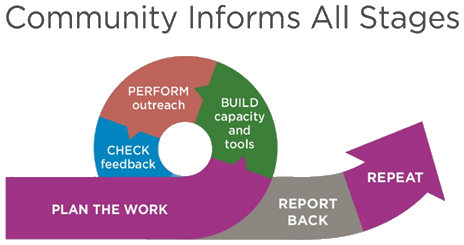About the Fun to Catch, Toxic to Eat Program
Promoting safe seafood consumption for the Lower Duwamish River Superfund Site
The purpose of this program is to protect the health of fishing communities, especially pregnant women, nursing moms and young children, from the contaminated seafood in the Duwamish River Superfund Site.
Public Health — Seattle & King County leads the Program work for the US Environmental Protection Agency (EPA). This program is part of EPA's plan to clean up the Duwamish River:
- Annual Program Fact Sheet, 2022
- របាយការណ៍៍ប្ររចាំំឆ្នាំំ 2022 (Khmer)
- Hoja Anual de Datos del Programa 2022 (Spanish)
- Thông tin chương trình hàng năm 2022 (Vietnamese)
- Annual Program Fact Sheet, 2021
- Annual Program Fact Sheet, 2020
- Annual Program Fact Sheet, 2019
- Annual Program Fact Sheet, 2018
- Annual Program Fact Sheet, 2017
Program focuses on API & Latino immigrant fishing communities
An EPA study found that more than 20 ethnic/language groups fish on the Duwamish River. Fishers from Asian, Pacific Islander (API), and Latino immigrant communities are catching, eating and sharing the contaminated seafood from the river. The health warning signs have not been effective in reaching fishers who speak little to no English – most of these fishers speak Vietnamese, Cambodian (Khmer) and Spanish.
The Program focuses on reaching these multi-ethnic fishers of the Duwamish River, as well as pregnant women, nursing moms and young children who received and prepare seafood from recreational fishers.
EPA's Duwamish Fisher Study fact sheet: Fishing in the Duwamish River: What did we learn and what do we do next?
The Program's community-based approach
This program reflects the Environmental Justice principles:
Capacity Building – hire and train community members to conduct peer outreach.
Meaningful Involvement – design tools and plans with community input.
Empowerment – support the community's voice in decision-making on this issue.
Program contacts
Public Health — Seattle & King County
Khanh Ho, Program Lead
206-263-0906, khho@kingcounty.gov
Also speaks: Vietnamese, Spanish
Ruben Chi Bertoni, Program Coordinator
206-848-0325, rbertoni@kingcounty.gov
Also speaks: Spanish
Environmental Protection Agency Region 10
Piper Peterson, Superfund Project Manager
206-553-4951, peterson.piper@epa.gov
Laura Knudsen, Community Involvement Coordinator
206-643-4299, knudsen.laura@epa.gov
In 2018, in partnership with ECOSS and Just Health Action, Public Health trained Community Health Advocates (CHAs) from the Cambodian, Vietnamese, and Latino fishing communities to help design and implement culturally appropriate outreach and tools.
Public Health also convenes a Community Steering Committee with CHAs and other community representatives to capture community input during the planning, implementation and evaluation of the Program.

The Institutional Control Implementation and Assurance Plan (ICIAP)
The Institutional Control Implementation and Assurance Plan (ICIAP) serves as a "living road map" that guides the work of this Fun to Catch, Toxic to Eat program toward its goal. This plan describes the key strategies to promote healthy seafood consumption that can be carried out within the scope of the program. In addition, the ICIAP has recommendations for partnerships to address additional barriers that are outside the scope of the EPA's program.
This plan is based on valuable input from the Community Steering Committee (June 2018 – May 2019) — made up of members from the Vietnamese, Cambodian, and Latino fishing communities. This ICIAP will be updated based on evaluation, monitoring, and community input throughout the cleanup process of the Lower Duwamish Waterway Superfund site.
- US EPA's ICIAP for Seafood Consumption at the Lower Duwamish Waterway (LDW) Superfund Site
- Executive Summary
- Khmer: គោលបំណងរបស់ដទៃការ ICIAP (ដទៃការកម្មវិធី)
- Spanish: Propósito del ICIAP (Plan del Programa)
- Vietnamese: Mục đích của ICIAP (kế hoạch chương trình)
- Appendix A: 2018 Community Steering Committee Group Charter
- Appendix B: 2018 Preliminary Evaluation Plan for the Community Health Advocate Outreach & Training Strategy
- Appendix C: Summary of Tools for Fishers and Moms
- Appendix D: Community Steering Committee Meetings (20.6 Mb)
- US EPA Fact Sheet: Duwamish Seafood Consumption ICIAP
- Khmer: ការទទួលទានអាហារសមុទ្ទឌូម៉ា មម៉ាស Duwamish ផែនការធានារ៉ាប់រង និងការអនុវត្តទ្ត្ួត្ពិនិត្យស្ថាប័ន (ICIAP)
- Spanish: El Plan de Implementación y Aseguramiento de Controles Institucionales (ICIAP)
- Vietnamese: Kế Hoạch Thực Hiện & Đảm Bảo Kiểm Soát Thể Chế (ICIAP)
Additional resources
- Community Health Advocate Q&A: Families, Fish and the Duwamish Superfund Site, Public Health Insider, Oct. 27, 2017
- Cambodian fishers work to protect their community from contaminated seafood in the Duwamish River, Voices for Clean Water, Dec. 5, 2018

 Translate
Translate